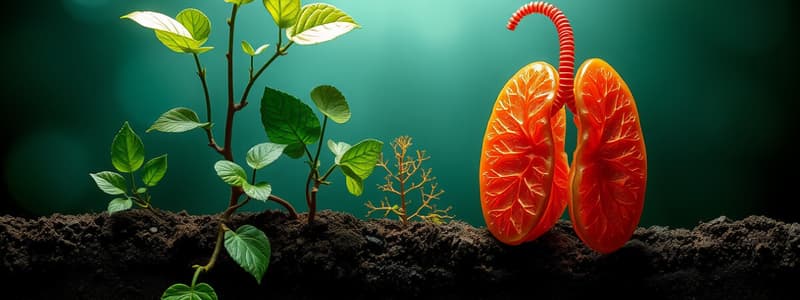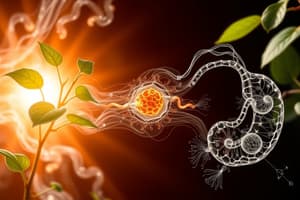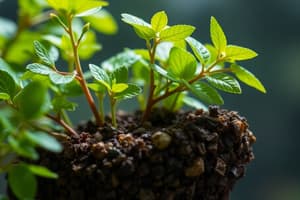Podcast
Questions and Answers
Which of the following are similarities between photosynthesis and respiration? (Select all that apply)
Which of the following are similarities between photosynthesis and respiration? (Select all that apply)
- Both provide power for cellular activities (correct)
- Both utilize glucose as reactants
- Both produce ATP through chemiosmosis (correct)
- Both involve ETC (correct)
What are the reactants and products of photosynthesis?
What are the reactants and products of photosynthesis?
- Reactants: CO2 and H2O; Products: glucose and O2 (correct)
- Reactants: glucose and O2; Products: CO2 and H2O
- Reactants: CO2 and glucose; Products: O2 and H2O
- Reactants: H2O and O2; Products: glucose and CO2
What is the main energy source for photosynthesis?
What is the main energy source for photosynthesis?
- Glucose
- Food
- Sunlight (correct)
- Oxygen
What are the similarities between the Calvin and Krebs cycles?
What are the similarities between the Calvin and Krebs cycles?
What are the main differences between the Calvin and Krebs cycles?
What are the main differences between the Calvin and Krebs cycles?
Which of the following statements is true for the electron transport chain (ETC) in photosynthesis?
Which of the following statements is true for the electron transport chain (ETC) in photosynthesis?
What are the similarities of the electron transport chain (ETC)?
What are the similarities of the electron transport chain (ETC)?
Compare chemiosmosis in photosynthesis and respiration.
Compare chemiosmosis in photosynthesis and respiration.
Which entities provide the reactants for cellular respiration?
Which entities provide the reactants for cellular respiration?
Flashcards are hidden until you start studying
Study Notes
Similarities between Photosynthesis and Respiration
- Both processes involve an electron transport chain (ETC).
- ATP is produced through chemiosmosis in each process.
- Occur within specific organelles: photosynthesis in chloroplasts and respiration in mitochondria.
- Both utilize ATP for energy during their respective cycles.
- Each provides energy necessary for various cellular activities.
Differences between Photosynthesis and Respiration
-
Photosynthesis:
- Reactants: carbon dioxide (CO2) and water (H2O); Products: glucose and oxygen (O2).
- Occurs in chloroplasts, which capture and convert sunlight into chemical energy.
- Primary purpose is glucose production.
- Involves two electron transport chains (ETC) and requires sunlight energy.
-
Respiration:
- Reactants: glucose and oxygen (O2); Products: carbon dioxide (CO2) and water (H2O).
- Takes place in mitochondria, where carbon-based molecules are broken down to release energy.
- Focuses on the utilization of glucose for energy.
- Involves one electron transport chain (ETC) with energy derived from food.
Similarities between the Calvin Cycle and Krebs Cycle
- Both take place in the interior spaces of organelles.
- Each consists of a series of cyclical chemical reactions.
Differences between Calvin Cycle and Krebs Cycle
-
Calvin Cycle:
- Constructs larger carbon-based molecules; exclusive to plants.
- Serves as the final stage of photosynthesis.
-
Krebs Cycle:
- Decomposes carbon-based molecules to generate energy and precursor molecules for the ETC.
- Found in both plants and animals, indicating broader functionality.
Differences in Electron Transport Chain (ETC) in Photosynthesis and Respiration
-
Photosynthesis:
- Uses NADP+ as an electron carrier.
- Electrons are energized by sunlight.
- NADPH serves as the primary electron acceptor.
- Involves two ETCs and utilizes CO2 and H2O as reactants.
-
Respiration:
- Employs NAD+ and FAD+ as electron carriers.
- Electrons originate from the oxidation of glucose.
- Oxygen serves as the primary electron acceptor.
- Involves one ETC, with energy acquired from catabolic processes.
Similarities of Electron Transport Chain (ETC)
- Functions to produce ATP in both photosynthesis and respiration.
- Chemiosmosis occurs in both systems to facilitate ATP generation.
- Electrons traverse down a concentration gradient, aiding in chemiosmosis.
- Both processes utilize ATP to sustain energy demands and generate a proton gradient.
Comparison of Chemiosmosis in Photosynthesis and Respiration
-
Photosynthesis:
- ATP production supports the Calvin cycle.
- Protons are pumped from the stroma into the thylakoid space using energy from electrons derived from chlorophyll.
-
Respiration:
- ATP production fuels cellular respiration processes.
- Protons are pumped from the mitochondrial matrix to the intermembrane space with energy sourced from organic molecules.
-
Both Processes:
- A proton gradient is essential for ATP synthesis.
- The flow is directed from the outer membrane into the inner membrane space during proton translocation.
Studying That Suits You
Use AI to generate personalized quizzes and flashcards to suit your learning preferences.




